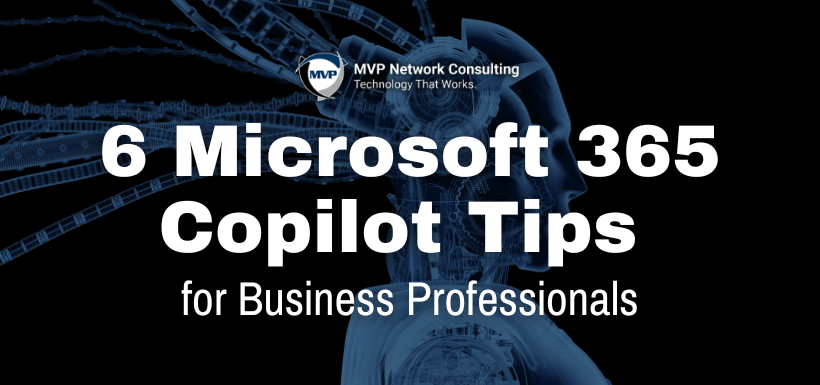June 2024 Newsletter
Leveraging advanced tools like Microsoft 365 Copilot can be a game-changer. Designed to enhance productivity and streamline workflows, Copilot utilizes AI to assist with various tasks, from generating emails to summarizing complex reports. To make the most out of this innovative tool, understanding how to craft effective prompts is crucial. Here are some strategies to help business professionals get the best results from Microsoft 365 Copilot.
#1: Start with the End in Mind
When using Copilot, clarity about your desired outcome is key. Define whether you need a structured memo, a casual email, or brainstorming ideas. For instance, specify, “Draft a thank you email in a casual, approachable style,” or, “Create a detailed project proposal with long, structured paragraphs.” By providing examples of the desired format and tone, Copilot can better mimic the output you seek which enhances the precision of its responses.
10 Easy Ways to Build a Culture of Cyber Awareness
 Cyberattacks are a constant threat. Phishing emails, malware, and data breaches can cripple businesses and devastate personal lives. A significant factor in many of these incidents is employee error, often due to a lack of cybersecurity awareness. People inadvertently click on phishing links or create weak passwords, making it easier for hackers to gain access.
Cyberattacks are a constant threat. Phishing emails, malware, and data breaches can cripple businesses and devastate personal lives. A significant factor in many of these incidents is employee error, often due to a lack of cybersecurity awareness. People inadvertently click on phishing links or create weak passwords, making it easier for hackers to gain access.
It's estimated that 95% of data breaches are due to human error. However, the good news is that these mistakes are preventable. By cultivating a strong culture of cyber awareness, you can significantly reduce these risks.
The Importance of Culture
Think of your organization’s cybersecurity as a chain. Strong links make it unbreakable, while weak links make it vulnerable. Employees are the links in this chain. Fostering a culture of cyber awareness turns each employee into a strong link, enhancing your entire organization's security.
Simple Steps for Significant Impact
Building a cyber-aware culture doesn't require complex strategies or expensive training programs. Here are some simple steps to make a big difference:
#1: Start with Leadership Buy-in
Security shouldn't be just an IT department issue. Leadership involvement sends a powerful message. Executives can demonstrate their commitment by:
- Speaking at security awareness events
- Allocating resources for ongoing initiatives
#2: Keep Training Short and Sweet
Opt for bite-sized training modules that are easy to digest and remember. Microlearning approaches delivered in short bursts throughout the workday are great for keeping employees engaged and reinforcing key security concepts.
#3: Conduct Phishing Drills
Regular phishing drills test employee awareness and preparedness. Send simulated phishing emails and track responses. Use the results to educate employees on recognizing and reporting suspicious messages. After drills, dissect the email with employees to highlight the telltale signs of a fake.
#4: Encourage and Simplify Reporting
Create a safe and easy reporting system for suspicious activity. Acknowledge reports promptly. This can be done through:
- A dedicated email address
- An anonymous reporting hotline
- A designated security champion employees can approach directly
#5: Empower Security Champions
Identify enthusiastic employees to become “security champions.” These champions can answer questions from peers and promote best practices, keeping security awareness top of mind.
#6: Extend Education Beyond the Workplace
Cybersecurity isn’t just a work issue. Educate employees on protecting themselves at home too. Share tips on strong passwords, secure Wi-Fi connections, and avoiding public hotspots. Good security habits at home often translate to better practices at work.
#7: Celebrate Successes
Recognize and celebrate achievements in cyber awareness. Publicly acknowledge contributions like reporting suspicious emails or achieving a low click-through rate on phishing drills. Recognition reinforces positive behavior and encourages continued vigilance.
#8: Leverage Technology
Use technology to support your cyber-aware culture. Online training platforms that deliver microlearning modules and track progress, automated phishing simulations, and tools like password managers, email filters, and DNS filtering can bolster employee security.
The Bottom Line: Shared Responsibility
Building a culture of cyber awareness is an ongoing process. Regularly revisit these steps and keep the conversation going to make security awareness a natural part of your organization’s DNA. Cybersecurity is a shared responsibility, and by fostering a culture of cyber awareness, you equip everyone in your organization with the knowledge and tools to stay safe online. Empowered employees are your strongest defense against cyber threats.
Catch of the Month: Healthcare Targeted Ransomware Attacks
 The healthcare sector continues to face significant threats from cyberattacks, with Ascension Health recently falling victim to a debilitating ransomware incident. The 140-hospital health system is currently working to investigate and restore its systems—a process that is progressing but will take time.
The healthcare sector continues to face significant threats from cyberattacks, with Ascension Health recently falling victim to a debilitating ransomware incident. The 140-hospital health system is currently working to investigate and restore its systems—a process that is progressing but will take time.
Ascension has notified law enforcement and other government bodies, including the FBI and CISA, and is sharing threat intelligence with the Health Information Sharing and Analysis Center (H-ISAC) to help protect industry peers. The attack has disrupted clinical care, forcing some clinicians to revert to paper records and diverting emergency services.
What to Do:
This incident underscores the critical need for robust cybersecurity measures in healthcare. With systems compromised and patient care impacted, the importance of a proactive, industry-wide approach to cyber threats cannot be overstated.
-
Conduct Regular Training
-
Implement Multi-Factor Authentication (MFA)
-
Regularly Update Systems
-
Back Up Data
-
Develop an Incident Response Plan
-
Engage with Cybersecurity Experts
By taking these proactive steps, healthcare organizations can strengthen their defenses against ransomware and other cyber threats, ensuring the safety and continuity of patient care.
Past Events
Mastering Microsoft 365: Essential Tips for Business Owners
In this video, you'll learn:
- Learn how to boost productivity using key Microsoft 365 applications.
- Discover effective strategies for data security and compliance within your Microsoft 365 environment.
- Explore advanced features and integrations that can drive innovation.
How to Simplify Compliance & Turn Risks into Opportunities for Business Growth
In this video, you'll learn:
- About the evolving regulatory landscape in 2024
- How to build an easy, proactive compliance strategy
- How to transform compliance challenges into business opportunities
How to Make Your Non-Profit Budget Work in the Current Cybersecurity Climate
In this video, you'll learn:
- The current cyber risks and technology challenges non-profits face
- Non-profit budgeting strategies for cybersecurity and technology
-
Sustaining donor trust in the digital age through data protection and privacy
MVP In The Community
MVP Network Consulting recently sponsored the Frank A. Disigner Memorial Golf Tournament, benefiting Niagara County Hospice and Shriners Children's Hospital. A heartfelt shout-out to our MVPs who showed up to play and support the cause. This charity provides essential care and services to those in need making a meaningful impact on our community.






